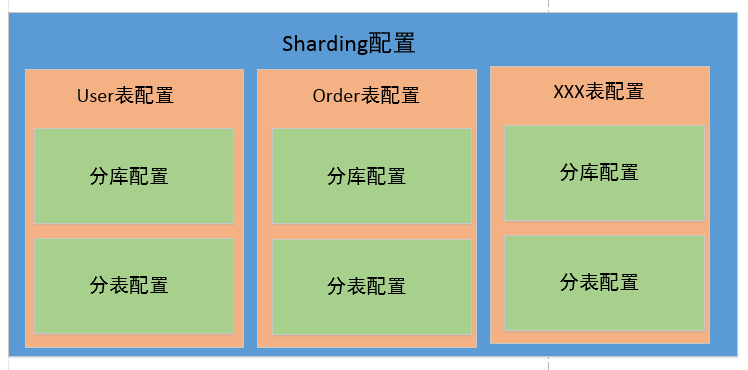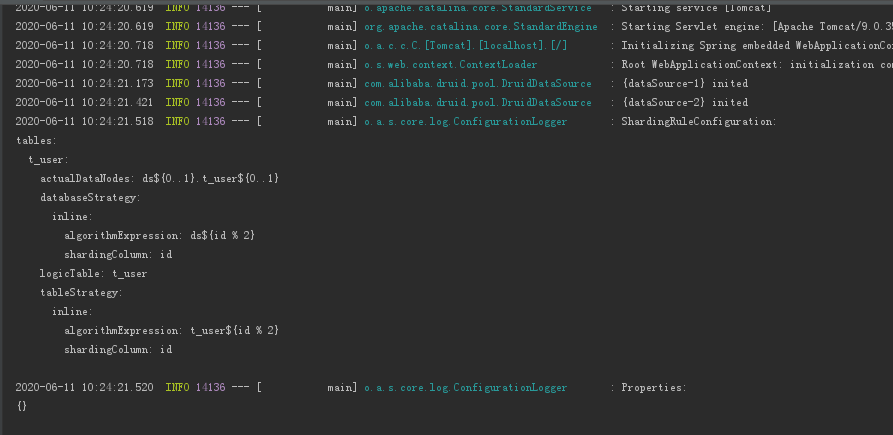SpringBoot 2.3 整合最新版 ShardingJdbc + Druid + MyBatis 实现分库分表
今天项目不忙,想搞一下shardingJDBC分库分表看看,主要想实现以下几点:
- 舍弃xml配置,使用.yml或者.properties文件+java的方式配置spring。
- 使用 Druid 作为数据库连接池,同时开启监控界面,并支持监控多数据源。
- 不依赖 com.dangdang 的 sharding-jdbc-core 包。此包过于古老,最后一次更新在2016年。目测只是封装了一层,意义不大。感觉如果不是dangdang公司内部开发,没必要用这个包。(且本人实测不能和最新的Druid包一起用,insert语句报错)
折腾了半天,网上找的例子大部分跑不通。直接自己从零开搞,全部组件直接上当前最新版本。
SpringBoot: 2.3.0
mybatis: 2.1.3
druid: 1.1.22
sharding-jdbc: 4.1.1
注意:这里因为是自己边看源码边配置,(sharding官网的例子可能是版本问题基本没法用,GitHub 我这里网络基本打不开),所以数据源和sharding大部分用java代码配置。了解配置原理后,也可以简化到 .yml / .properties 文件中。
Sharding-JDBC简介
Apache ShardingSphere 是一套开源的分布式数据库中间件解决方案组成的生态圈,它由 JDBC、Proxy 和 Sidecar(规划中)这 3 款相互独立,却又能够混合部署配合使用的产品组成。
Sharding-JDBC定位为轻量级 Java 框架,在 Java 的 JDBC 层提供的额外服务。 它使用客户端直连数据库,以 jar 包形式提供服务,无需额外部署和依赖,可理解为增强版的 JDBC 驱动,完全兼容 JDBC 和各种 ORM 框架。
- 适用于任何基于 JDBC 的 ORM 框架,如:JPA, Hibernate, Mybatis, Spring JDBC Template 或直接使用 JDBC。
- 支持任何第三方的数据库连接池,如:DBCP, C3P0, BoneCP, Druid, HikariCP 等。
- 支持任意实现JDBC规范的数据库。目前支持 MySQL,Oracle,SQLServer,PostgreSQL 以及任何遵循 SQL92 标准的数据库。
Sharding配置示意图
简单的理解如下图,对sharding-jdbc进行配置,其实就是对所有需要进行分片的表进行配置。对表的配置,则主要是对分库的配置和分表的配置。这里可以只分库不分表,或者只分表不分库,或者同时包含分库和分表逻辑。

先看一下我的项目目录结构整体如下:

一、POM依赖配置
完整的pom表如下,其中主要是对 mysql-connector-java、mybatis-spring-boot-starter、druid-spring-boot-starter、sharding-jdbc-core 的依赖。
注意:sharding-jdbc-core 我用的4.0+的版本,因为已经晋升为 apache 基金会的顶级项目,其 groupId 变为了 org.apache.shardingsphere,之前是io.shardingsphere。

<?xml version="1.0" encoding="UTF-8"?> <project xmlns="http://maven.apache.org/POM/4.0.0" xmlns:xsi="http://www.w3.org/2001/XMLSchema-instance" xsi:schemaLocation="http://maven.apache.org/POM/4.0.0 https://maven.apache.org/xsd/maven-4.0.0.xsd"> <modelVersion>4.0.0</modelVersion> <parent> <groupId>org.springframework.boot</groupId> <artifactId>spring-boot-starter-parent</artifactId> <version>2.3.0.RELEASE</version> <relativePath/> <!-- lookup parent from repository --> </parent> <groupId>com.example</groupId> <artifactId>shardingjdbc</artifactId> <version>0.0.1-SNAPSHOT</version> <name>shardingjdbc</name> <description>Demo project for Spring Boot</description> <properties> <!--<sharding.jdbc.version>3.0.0</sharding.jdbc.version>--> <java.version>1.8</java.version> </properties> <dependencies> <dependency> <groupId>org.springframework.boot</groupId> <artifactId>spring-boot-starter-web</artifactId> </dependency> <dependency> <groupId>org.springframework</groupId> <artifactId>spring-tx</artifactId> </dependency> <dependency> <groupId>mysql</groupId> <artifactId>mysql-connector-java</artifactId> <scope>runtime</scope> </dependency> <dependency> <groupId>org.mybatis.spring.boot</groupId> <artifactId>mybatis-spring-boot-starter</artifactId> <version>2.1.3</version> </dependency> <dependency> <groupId>com.alibaba</groupId> <artifactId>druid-spring-boot-starter</artifactId> <version>1.1.22</version> </dependency> <dependency> <groupId>org.apache.shardingsphere</groupId> <artifactId>sharding-jdbc-core</artifactId> <version>4.1.1</version> </dependency> <dependency> <groupId>org.projectlombok</groupId> <artifactId>lombok</artifactId> <optional>true</optional> </dependency> <dependency> <groupId>org.springframework.boot</groupId> <artifactId>spring-boot-starter-test</artifactId> <scope>test</scope> <exclusions> <exclusion> <groupId>org.junit.vintage</groupId> <artifactId>junit-vintage-engine</artifactId> </exclusion> </exclusions> </dependency> <dependency> <groupId>log4j</groupId> <artifactId>log4j</artifactId> <version>1.2.16</version> </dependency> <dependency> <groupId>org.slf4j</groupId> <artifactId>slf4j-log4j12</artifactId> <version>1.7.5</version> </dependency> </dependencies> <build> <resources> <resource> <directory>src/main/java</directory> <includes> <include>**/*.xml</include> </includes> </resource> </resources> <plugins> <plugin> <groupId>org.apache.maven.plugins</groupId> <artifactId>maven-compiler-plugin</artifactId> <configuration> <source>1.8</source> <target>1.8</target> <encoding>UTF-8</encoding> </configuration> </plugin> <plugin> <groupId>org.springframework.boot</groupId> <artifactId>spring-boot-maven-plugin</artifactId> </plugin> </plugins> </build> </project>
二、application.properties
这里配置了两个数据源,为避免和自动装配产生冲突,属性前缀要和自动装配扫描的前缀区分开,这里我用 datasource0 和 datasource1。
下面 spring.datasource.druid 开头的配置,会被 druid 的代码自动扫描装配。
#################################### common config : #################################### spring.application.name=shardingjdbc # 应用服务web访问端口 server.port=8080 # mybatis配置 mybatis.mapper-locations=classpath:com/example/shardingjdbc/mapper/*.xml mybatis.type-aliases-package=com.example.shardingjdbc.**.entity datasource0.url=jdbc:mysql://localhost:3306/test0?useUnicode=true&characterEncoding=utf-8&useSSL=false&serverTimezone=Asia/Shanghai datasource0.driver-class-name=com.mysql.cj.jdbc.Driver datasource0.type=com.alibaba.druid.pool.DruidDataSource datasource0.username=root datasource0.password=852278 datasource1.url=jdbc:mysql://localhost:3306/test1?useUnicode=true&characterEncoding=utf-8&useSSL=false&serverTimezone=Asia/Shanghai datasource1.driver-class-name=com.mysql.cj.jdbc.Driver datasource1.type=com.alibaba.druid.pool.DruidDataSource datasource1.username=root datasource1.password=852278 # ##### 连接池配置 ####### # 过滤器设置(第一个stat很重要,没有的话会监控不到SQL) spring.datasource.druid.filters=stat,wall,log4j2 ##### WebStatFilter配置 ####### #启用StatFilter spring.datasource.druid.web-stat-filter.enabled=true #添加过滤规则 spring.datasource.druid.web-stat-filter.url-pattern=/* #排除一些不必要的url spring.datasource.druid.web-stat-filter.exclusions=*.js,*.gif,*.jpg,*.png,*.css,*.ico,/druid/* #开启session统计功能 spring.datasource.druid.web-stat-filter.session-stat-enable=true #缺省sessionStatMaxCount是1000个 spring.datasource.druid.web-stat-filter.session-stat-max-count=1000 #spring.datasource.druid.web-stat-filter.principal-session-name= #spring.datasource.druid.web-stat-filter.principal-cookie-name= #spring.datasource.druid.web-stat-filter.profile-enable= ##### StatViewServlet配置 ####### #启用内置的监控页面 spring.datasource.druid.stat-view-servlet.enabled=true #内置监控页面的地址 spring.datasource.druid.stat-view-servlet.url-pattern=/druid/* #关闭 Reset All 功能 spring.datasource.druid.stat-view-servlet.reset-enable=false #设置登录用户名 spring.datasource.druid.stat-view-servlet.login-username=admin #设置登录密码 spring.datasource.druid.stat-view-servlet.login-password=123 #白名单(如果allow没有配置或者为空,则允许所有访问) spring.datasource.druid.stat-view-servlet.allow=127.0.0.1 #黑名单(deny优先于allow,如果在deny列表中,就算在allow列表中,也会被拒绝) spring.datasource.druid.stat-view-servlet.deny=
三、数据源和分片配置
如下代码,先从配置文件读取数据源的所需要的属性,然后生成 Druid 数据源。注意这里配置语句中的 setFilters,如果不添加 filters,则 Duird 监控界面无法监控到sql。另外,其他诸如最大连接数之类的属性这里没有配,按需配置即可。数据源创建好后,添加到 dataSourceMap 集合中。
再往下注释比较清楚,构造 t_user 表的分片规则(包括分库规则 + 分表规则),然后将所有表的分片规则组装成 ShardingRuleConfiguration。
最后,将前两步配好的 dataSourceMap 和 shardingRuleConfiguration 交给 ShardingDataSourceFactory,用来构造数据源。
到这里,sharding 、druid 的配置代码就都写好了。剩下基本都是业务代码了。

package com.example.shardingjdbc.config; import com.alibaba.druid.pool.DruidDataSource; import com.example.shardingjdbc.sharding.UserShardingAlgorithm; import org.apache.shardingsphere.api.config.sharding.ShardingRuleConfiguration; import org.apache.shardingsphere.api.config.sharding.TableRuleConfiguration; import org.apache.shardingsphere.api.config.sharding.strategy.StandardShardingStrategyConfiguration; import org.apache.shardingsphere.shardingjdbc.api.ShardingDataSourceFactory; import org.springframework.beans.factory.annotation.Value; import org.springframework.context.annotation.Bean; import org.springframework.context.annotation.Configuration; import javax.sql.DataSource; import java.util.HashMap; import java.util.Map; import java.util.Properties; @Configuration public class DataSourceConfig { @Value("${datasource0.url}") private String url0; @Value("${datasource0.username}") private String username0; @Value("${datasource0.password}") private String password0; @Value("${datasource0.driver-class-name}") private String driverClassName0; @Value("${datasource1.url}") private String url1; @Value("${datasource1.username}") private String username1; @Value("${datasource1.password}") private String password1; @Value("${datasource1.driver-class-name}") private String driverClassName1; @Value(("${spring.datasource.druid.filters}")) private String filters; @Bean("dataSource") public DataSource dataSource() { try { DruidDataSource dataSource0 = new DruidDataSource(); dataSource0.setDriverClassName(this.driverClassName0); dataSource0.setUrl(this.url0); dataSource0.setUsername(this.username0); dataSource0.setPassword(this.password0); dataSource0.setFilters(this.filters); DruidDataSource dataSource1 = new DruidDataSource(); dataSource1.setDriverClassName(this.driverClassName1); dataSource1.setUrl(this.url1); dataSource1.setUsername(this.username1); dataSource1.setPassword(this.password1); dataSource1.setFilters(this.filters); //分库设置 Map<String, DataSource> dataSourceMap = new HashMap<>(2); //添加两个数据库database0和database1 dataSourceMap.put("ds0", dataSource0); dataSourceMap.put("ds1", dataSource1); // 配置 t_user 表规则 TableRuleConfiguration userRuleConfiguration = new TableRuleConfiguration("t_user", "ds${0..1}.t_user${0..1}"); // 配置分表规则 userRuleConfiguration.setTableShardingStrategyConfig(new StandardShardingStrategyConfiguration("id", UserShardingAlgorithm.tableShardingAlgorithm)); // 配置分库规则 userRuleConfiguration.setDatabaseShardingStrategyConfig(new StandardShardingStrategyConfiguration("id", UserShardingAlgorithm.databaseShardingAlgorithm)); // Sharding全局配置 ShardingRuleConfiguration shardingRuleConfiguration = new ShardingRuleConfiguration(); shardingRuleConfiguration.getTableRuleConfigs().add(userRuleConfiguration); // 创建数据源 DataSource dataSource = ShardingDataSourceFactory.createDataSource(dataSourceMap, shardingRuleConfiguration, new Properties()); return dataSource; } catch (Exception ex) { ex.printStackTrace(); return null; } } }
上面构造分片规则的时候,我定义了User表的分片算法类 UserShardingAlgorithm,并定义了两个内部类分别实现了数据库分片和表分片的逻辑。代码如下:

package com.example.shardingjdbc.sharding; import org.apache.shardingsphere.api.sharding.standard.PreciseShardingAlgorithm; import org.apache.shardingsphere.api.sharding.standard.PreciseShardingValue; import java.util.Collection; public class UserShardingAlgorithm { public static final DatabaseShardingAlgorithm databaseShardingAlgorithm = new DatabaseShardingAlgorithm(); public static final TableShardingAlgorithm tableShardingAlgorithm = new TableShardingAlgorithm(); static class DatabaseShardingAlgorithm implements PreciseShardingAlgorithm<Long> { @Override public String doSharding(Collection<String> databaseNames, PreciseShardingValue<Long> shardingValue) { for (String database : databaseNames) { if (database.endsWith(String.valueOf(shardingValue.getValue() % 2))) { return database; } } return ""; } } static class TableShardingAlgorithm implements PreciseShardingAlgorithm<Long> { @Override public String doSharding(Collection<String> tableNames, PreciseShardingValue<Long> shardingValue) { for (String table : tableNames) { if (table.endsWith(String.valueOf(shardingValue.getValue() % 2))) { return table; } } return ""; } } }
这里实现分片规则时,实现的接口是 PreciseShardingAlgorithm,即精确分片,将指定的键值记录映射到指定的1张表中(最多1张表)。这个接口基本上能满足80%的需求了。
其他的还有 Range、ComplexKey、Hint分片规则,这3种都可以将符合条件的键值记录映射到多张表,即可以将记录 a 同时插入A、B 或 B、C多张表中。
其中,
Range 是范围筛选分片。我个人理解,比如id尾数1-5插入A表,6-0插入B表,这种情况,使用Range作为筛选条件更方便。也可以根据时间范围分片。(如有误请指正)。
ComplexKey 看名字就是组合键分片,可以同时根据多个键,制定映射规则。
Hint 看名字没看懂,但看源码其实也是组合键分片,但仅支持对组合键进行精确筛选。
而 ComplexKey 支持对组合键进行范围筛选。所以可以理解为 ComplexKey 是 Hint 的高级版本。
不管实现哪种分片算法,都要确保算法覆盖所有可能的键值。

四、使用行表达式配置分片策略(对第三步优化,可略过)
上面第三步,我们通过实现 PreciseShardingValue 接口,来定义分片算法。这样每有一张表需要分片,都要重新定义一个类,太麻烦。
Sharding 提供了行表达式配置的方式,对简单的分片逻辑,直接定义一个行表达式即可。(这种方式其实就是直接在 .yml 文件中配置分片策略的解析方式)
和上面的代码类似,这里之改动了6、8行,直接 new 一个 InlineShardingStrategyConfiguration,省去了定义分片算法类的繁琐步骤。
1 // .....省略其他代码 2 3 // 配置 t_user 表规则 4 TableRuleConfiguration userRuleConfiguration = new TableRuleConfiguration("t_user", "ds${0..1}.t_user${0..1}"); 5 // 行表达式分表规则 6 userRuleConfiguration.setTableShardingStrategyConfig(new InlineShardingStrategyConfiguration("id", "t_user${id % 2}")); 7 // 行表达式分库规则 8 userRuleConfiguration.setDatabaseShardingStrategyConfig(new InlineShardingStrategyConfiguration("id", "ds${id % 2}")); 9 10 // Sharding全局配置 11 ShardingRuleConfiguration shardingRuleConfiguration = new ShardingRuleConfiguration(); 12 shardingRuleConfiguration.getTableRuleConfigs().add(userRuleConfiguration); 13 // 创建数据源 14 DataSource dataSource = ShardingDataSourceFactory.createDataSource(dataSourceMap, shardingRuleConfiguration, new Properties()); 15 return dataSource;
五、分布式主键(雪花算法)
分库后,不能再使用 mysql 的自增主键,否则会产生重复主键。自定义主键,主要需要解决两个问题:
- 主键唯一(必须)
- 主键单调递增(可选)(提升索引效率,减少索引重排产生的空间碎片)
Sharding 内部提供了2个主键生成器,一个使用雪花算法 SnowflakeShardingKeyGenerator,一个使用 UUID(考虑上面第2条,因此不使用 UUID)。
雪花算法的主要原理:用一个 64 bit 的 long 型数字做主键。其中,
第 1 位,1 bit 作为符号位永远为 0,表示是正数。
第 2 - 42 位, 41 个 bit 填充时间戳。
第 43 - 52 位,10 个 bit 填充机器唯一id。举个例子,可以用前4位标识机房号,后6位标识机器号。
第 53 - 64 位,12 个 bit 填充id序号。范围 0 - 4095,即每台机器每 1 毫秒最多生成 4096 个不同的主键id。
雪花算法的主要实现代码如下:
- 先判断时钟是否回调。这里默认容忍回调时间为0,如有回调则会产生异常。可以通过配置 max.tolerate.time.difference.milliseconds 属性,让其自旋等待时钟回到上一次执行时间。
- 按当前毫秒数,递增生成id序号。如果时钟进入了下一毫秒,则从0开始重新生成id序号,范围 0 - 4095。
- 将 时间戳 + 机器序号 + id序号 拼装成 主键id。这里机器序号默认为0,可以通过 worker.id 属性进行配置。不同的服务器需要配置成不同的数字,范围 0 - 1023。
其中 EPOCH 是时钟起点,sharding中设置的是2016年11月1日,那么41位的时间戳差不多可以用70年,一直到2086年。
public synchronized Comparable<?> generateKey() { long currentMilliseconds = timeService.getCurrentMillis(); if (this.waitTolerateTimeDifferenceIfNeed(currentMilliseconds)) { currentMilliseconds = timeService.getCurrentMillis(); } if (this.lastMilliseconds == currentMilliseconds) { if (0L == (this.sequence = this.sequence + 1L & 4095L)) { currentMilliseconds = this.waitUntilNextTime(currentMilliseconds); } } else { this.vibrateSequenceOffset(); this.sequence = (long)this.sequenceOffset; } this.lastMilliseconds = currentMilliseconds; return currentMilliseconds - EPOCH << 22 | this.getWorkerId() << 12 | this.sequence; }
六、业务代码
使用分布式的主键ID生成器,需要给不同的表注入不同的ID生成器,在config包下加一个KeyIdConfig类,如下:
(为了保持时钟的统一,可以专门找一台机器作为时钟服务,然后给所有主键生成器配置统一的时钟服务。下图中未配置,如需配置,直接调用setTimeService方法即可)
@Configuration public class KeyIdConfig { @Bean("userKeyGenerator") public SnowflakeShardingKeyGenerator userKeyGenerator() { return new SnowflakeShardingKeyGenerator(); } @Bean("orderKeyGenerator") public SnowflakeShardingKeyGenerator orderKeyGenerator() { return new SnowflakeShardingKeyGenerator(); } }
其他业务代码,整体如下:

package com.example.shardingjdbc.entity; import lombok.Data; import java.io.Serializable; import java.util.Date; @Data public class User implements Serializable { private Long id; private String name; private String phone; private String email; private String password; private Integer cityId; private Date createTime; private Integer sex; }

package com.example.shardingjdbc.mapper; import com.example.shardingjdbc.entity.User; import org.apache.ibatis.annotations.Mapper; import java.util.List; public interface UserMapper { /** * 保存 */ void save(User user); /** * 查询 * @param id * @return */ User get(Long id); }

<?xml version="1.0" encoding="UTF-8" ?> <!DOCTYPE mapper PUBLIC "-//mybatis.org//DTD Mapper 3.0//EN" "http://mybatis.org/dtd/mybatis-3-mapper.dtd"> <mapper namespace="com.example.shardingjdbc.mapper.UserMapper"> <resultMap id="resultMap" type="com.example.shardingjdbc.entity.User"> <id column="id" property="id" /> <result column="name" property="name" /> <result column="phone" property="phone" /> <result column="email" property="email" /> <result column="password" property="password" /> <result column="city_id" property="cityId" /> <result column="create_time" property="createTime" /> <result column="sex" property="sex" /> </resultMap> <insert id="save"> insert into t_user (id, name, phone, email, password, city_id, create_time, sex) values (#{id}, #{name}, #{phone}, #{email}, #{password}, #{cityId}, #{createTime}, #{sex}) </insert> <select id="get" resultMap="resultMap"> select * from t_user where id = #{id} </select> </mapper>

1 package com.example.shardingjdbc.controller; 2 3 import com.example.shardingjdbc.entity.User; 4 import com.example.shardingjdbc.mapper.UserMapper; 5 import org.apache.shardingsphere.core.strategy.keygen.SnowflakeShardingKeyGenerator; 6 import org.springframework.beans.factory.annotation.Autowired; 7 import org.springframework.stereotype.Controller; 8 import org.springframework.web.bind.annotation.PathVariable; 9 import org.springframework.web.bind.annotation.RequestMapping; 10 import org.springframework.web.bind.annotation.ResponseBody; 11 12 import javax.annotation.Resource; 13 import java.util.Date; 14 15 @Controller 16 public class UserController { 17 @Autowired 18 private UserMapper userMapper; 19 20 @Resource 21 SnowflakeShardingKeyGenerator userKeyGenerator; 22 23 @RequestMapping("/user/save") 24 @ResponseBody 25 public String save() { 26 for (int i = 0; i < 50; i++) { 27 Long id = (Long)userKeyGenerator.generateKey(); 28 User user = new User(); 29 user.setId(id); 30 user.setName("test" + i); 31 user.setCityId(i); 32 user.setCreateTime(new Date()); 33 user.setSex(i % 2 == 0 ? 1 : 2); 34 user.setPhone("11111111" + i); 35 user.setEmail("xxxxx"); 36 user.setCreateTime(new Date()); 37 user.setPassword("eeeeeeeeeeee"); 38 userMapper.save(user); 39 } 40 41 return "success"; 42 } 43 44 @RequestMapping("/user/get/{id}") 45 @ResponseBody 46 public User get(@PathVariable Long id) { 47 User user = userMapper.get(id); 48 return user; 49 } 50 }

1 CREATE TABLE `t_user` ( 2 `id` bigint(20) NOT NULL, 3 `name` varchar(64) DEFAULT NULL COMMENT '名称', 4 `city_id` int(12) DEFAULT NULL COMMENT '城市', 5 `sex` tinyint(1) DEFAULT NULL COMMENT '性别', 6 `phone` varchar(32) DEFAULT NULL COMMENT '电话', 7 `email` varchar(32) DEFAULT NULL COMMENT '邮箱', 8 `create_time` timestamp NOT NULL DEFAULT CURRENT_TIMESTAMP ON UPDATE CURRENT_TIMESTAMP COMMENT '创建时间', 9 `password` varchar(32) DEFAULT NULL COMMENT '密码', 10 PRIMARY KEY (`id`) 11 ) ENGINE=InnoDB DEFAULT CHARSET=utf8;
启动类如下:

1 package com.example.shardingjdbc; 2 3 import org.mybatis.spring.annotation.MapperScan; 4 import org.springframework.boot.SpringApplication; 5 import org.springframework.boot.autoconfigure.SpringBootApplication; 6 7 @MapperScan("com.example.shardingjdbc.mapper") 8 @SpringBootApplication 9 public class ShardingjdbcApplication { 10 public static void main(String[] args) { 11 SpringApplication.run(ShardingjdbcApplication.class, args); 12 } 13 }
注意,这里我在启动类上加了 @MapperScan 注解。可能是因为引用依赖的问题,.properties 配置的 mybatis 包扫描目录不管用了,后面有时间再研究。
七、其他
除了基本的分库分表规则以外,还有一些其他的配置,比如绑定表。这里先不详细解释了,举个简单的例子:
现在有 order, order_detail两张表,1 : 1的关系。
在配置的时候,应该将相同 order_id 的 order 记录 和 order_detail 记录 映射到相同尾号的表中,方便连接查询。
比如 id % 2 = 1的,都插入到 order0, order_detail0 中。
如果配置了绑定关系,那么查找 id = 1 的记录,只会产生一次查询 select * from order0 as o join order_detail0 as d on o.order_id = d.order_id where o.oder_id = 1。
否则会产生笛卡儿积查询,
select * from order0 as o join order_detail0 as d on o.order_id = d.order_id where o.order_id = 1
select * from order0 as o join order_detail1 as d on o.order_id = d.order_id where o.order_id = 1
select * from order1 as o join order_detail0 as d on o.order_id = d.order_id where o.order_id = 1
select * from order1 as o join order_detail1 as d on o.order_id = d.order_id where o.order_id = 1
八、总结
项目启动前,先创建数据库 test0, test1, 然后分别建表 t_user0, t_user1。 可以全部在同一台机器。
项目启动后,访问 http://localhost:8080/user/save, id 是 偶数的都插入到了 test0 库的 t_user0 表中, 奇数的都插入到了 test1 库中的 t_user1 表中。
druid 的后台监控页面地址: http://localhost:8080/druid/。
项目启动后,sharding日志会将配置已 yml 格式的形式打印出来,也可以省去 java 配置,将其优化到 .yml 配置文件中去,如下图:

本文原文地址:https://www.cnblogs.com/lyosaki88/p/springboot_shardingjdbc_druid_mybatis.html
源码下载地址:https://474b.com/file/14960372-448059323
作者QQ: 116269651



 浙公网安备 33010602011771号
浙公网安备 33010602011771号